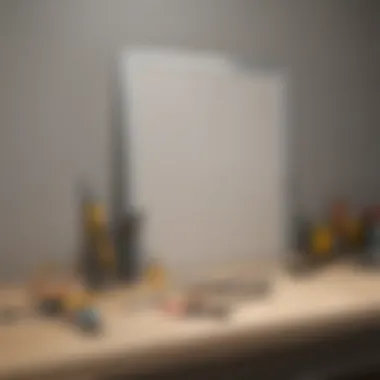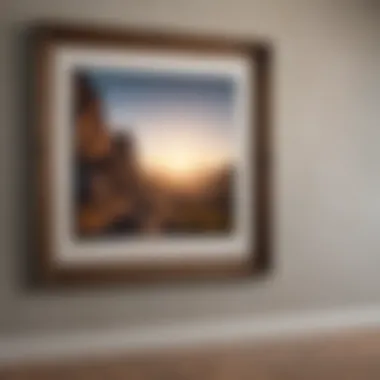Expert Tips for Hanging Frames on Drywall


Intro
Hanging frames on drywall may seem a straightforward task, yet many encounter challenges when striving for both function and aesthetic appeal. This guide aims to empower you with knowledge about various methods and tools that will help you hang frames securely while aligning them with your personal decor style.
Understanding drywall types, the tools required, and the best techniques for different frame weights is crucial for anyone looking to enhance their interior space.
In the following sections, we will explore these elements in detail, highlight common pitfalls, and provide remedies to ensure your artwork is displayed beautifully and safely.
Feature Spotlight
Exceptional Architectural Designs
Frames serve not only to hold and protect artwork but also to complement architectural features of a room. Choosing styles that align with your interior design can transform the look and feel of a space. For example, sleek metallic frames can enhance a modern aesthetic, whereas rustic wooden frames fit seamlessly with traditional or farmhouse designs.
When selecting frames, consider their weight and size in relation to your wall space and surrounding furniture. A large, heavy frame demands more robust methods of support compared to lighter counterparts.
Unique Decor Elements
Your choice of frames can be a reflection of your personal style. Mixing different sizes, colors, and materials can create a gallery wall that speaks volumes about your tastes and interests. Utilize various frame styles to establish a dynamic visual impact. Think about whether the color scheme should align with other elements in the room or serve as a bold contrast.
Tools Needed for Hanging Frames
Hanging frames requires specific tools to ensure success. Here are some essential items to have on hand:
- Measuring tape: Accurate measurements are vital to achieving even spacing and alignment.
- Level: Ensures your frames hang straight.
- Drill or hammer: Depending on the hooks or anchors you are using, a drill for wall anchors or a hammer for nails is necessary.
- Wall anchors: Useful for heavier frames to provide additional support.
- Picture hooks: Choose hooks that can withstand the weight of your frame.
Having these tools will help facilitate a smooth process when hanging your frames on drywall.
Considerations for Frame Weight
When selecting how to hang a frame, it’s essential to consider its weight. Light frames (up to 5 pounds) can typically be secured with simple nails or adhesive hooks. Medium frames (5 to 20 pounds) often require picture hanging hooks and possibly wall anchors. For heavy frames exceeding 20 pounds, it is advisable to locate a stud in the wall where you can use screws for strong support.
Common Pitfalls and Remedies
Many individuals encounter certain mistakes when hanging frames. A few common pitfalls include:
- Improper height placement: Frames should be hung at eye level, generally about 57 to 60 inches from the floor.
- Over or underestimating weight: Using inadequate support for heavy frames can lead to accidents.
- Not measuring space between frames: Consistent spacing enhances visual appeal, so measuring before hammering is key.
"Hanging art is a delicate balance of creativity and practicality. Choosing the right method can ensure both display and safety."
By being mindful of these issues and applying the appropriate solutions, you will enhance the overall beauty and safety of your interior spaces.
Understanding Drywall
Understanding drywall is crucial when it comes to hanging frames. Drywall serves as the primary wall material in most modern homes. Recognizing its composition, structure, and types will guide you in selecting suitable techniques for securing frames.
Understanding the properties of drywall helps in making informed choices about tools and methods you will use. For instance, using the wrong type of fasteners can lead to damage, frames falling, or worse, injury. Knowledge about drywall can save time and ensure that your framed art is presented beautifully and securely.
Composition and Structure of Drywall
Drywall, also known as gypsum board or plasterboard, consists of a core made from gypsum, sandwiched between two sheets of heavy paper. The gypsum core is what gives drywall its fire-resistant qualities. Most drywall boards are 1/2 inch thick, but variations exist. The composition plays a significant role in how weight is distributed when you hang something from it.
The structure of drywall is relatively fragile when compared to traditional wooden walls. It is designed for interior use and might not hold heavy frames well without proper supports. When considering how to hang a frame, it’s important to understand what type of anchors work best for your specific drywall structure.
Types of Drywall: A Brief Overview
Different types of drywall exist, each serving distinct purposes.
- Regular Gypsum Board: Standard type used in most residential walls. It’s suitable for normal living spaces.
- Moisture-Resistant Board: Also known as green board, it is used in areas with high humidity like bathrooms. It’s wise to use this for frames that may hang near such areas.
- Fire-Resistant Board: This type is designed for added fire protection, beneficial in walls that separate living spaces from garages or utility areas.
- Soundproof Board: Made for reducing noise transmission, this board is useful if you want to minimize sound from adjoining rooms.
Choosing the appropriate drywall type can not only affect the ease of hanging frames but also the overall safety and maintenance of the wall structures in your home.


Understanding these elements will aid in more effective and pleasing home decor decisions, ultimately improving your living space.
Preparing to Hang a Frame
Hanging a frame might seem simple, but it involves several crucial steps that ensure a secure and visually appealing setup. Preparing to hang a frame is more than just the act of placement; it requires thoughtful consideration of various elements to achieve the desired outcome. This section emphasizes the importance of selecting the right frame, gathering appropriate tools, and accurately measuring and marking the wall, all of which lay the groundwork for a successful hanging.
Selecting the Right Frame
Selecting the right frame is fundamental to the overall aesthetic and structural integrity of your display. Different frame styles, materials, and sizes can significantly impact how the artwork or photo appears on the wall. When choosing a frame, consider the artwork it will contain. A heavy frame with intricate detailing may require different hanging techniques compared to a lightweight, minimalist one.
Additionally, the frame should harmonize with the existing decor. For example, a wooden frame might complement rustic interiors, while a sleek metal frame could suit a modern setting. Matching the frame to the style of the room ensures consistency and can enhance the overall decor. The size of the frame also plays a role; it must be proportionate to the wall space and other elements in the room.
Gathering Required Tools
Before you start hanging, gathering the right tools is essential. Having the necessary equipment makes the process smoother and ensures the frame is secure.
Measuring Tools
Measuring tools are vital in accurately positioning the frame on the wall. A tape measure is a key component, allowing you to determine the exact dimensions of the space. It enables you to find the center of the wall or the desired height for the frame.
A level is another important measuring tool. It guarantees that the frame hangs straight, making the display visually pleasing. Utilizing a level prevents the frustration of having to adjust the frame multiple times after hanging.
The primary advantage of high-quality measuring tools is precision. They minimize the chances of mistakes and ultimately enhance the finished look of the display.
Fastening Equipment
Fastening equipment is just as crucial in the frame hanging process. The type of fasteners used must correspond to both the weight of the frame and the type of drywall. Common options include picture hooks, nails, and wall anchors.
Using appropriate fastening equipment ensures that the frame won't come loose or fall off over time. For lightweight frames, simple picture hangers work well, while heavier frames may require the support of wall anchors for added security. The unique feature of fastening equipment is its ability to distribute weight evenly across the anchor points, reducing stress on the drywall. This means that using the correct type results in a long-lasting hanging solution.
Leveling Devices
Leveling devices, including laser levels and spirit levels, help verify that your frame is positioned correctly. A laser level can project a straight line across the wall, making it easier to align multiple frames, especially in gallery-style setups.
The key characteristic of leveling devices is their accuracy. They can point out even minor discrepancies that may undermine the appearance of the frame. While they may not be strictly necessary for smaller projects, incorporating them can lead to a neat and well-aligned display.
Measuring and Marking the Wall
Measuring and marking the wall is where preparation transforms into a clear plan. This step involves determining the best place for the frame, typically at eye level for optimum viewing. Using your measuring tools, find the desired height and mark it lightly with a pencil. Consider the frame's size, ensuring there is enough space around it to prevent a cramped look. This process not only increases the chance of a successful installation but also enhances the overall aesthetic of the space.
Hanging Techniques Based on Frame Weight
When it comes to hanging frames on drywall, recognizing the weight of the frame is essential. Different hanging techniques apply depending on whether the frames are lightweight, medium-weight, or heavy-duty. Each category has specific requirements that ensure stability and longevity. Choosing the right method impacts both the integrity of your wall and the design aesthetic of your space. By understanding these techniques, one can efficiently secure frames while also avoiding common issues that arise from improper installations.
Lightweight Frames
Nail and Picture Hangers
Nail and picture hangers are a commonly used method for hanging lightweight frames. Their key characteristic is simplicity; these small items can easily support frames weighing up to several pounds. This approach is beneficial due to its ease of use. For most homeowners, a humble hammer suffices to drive the hanger into the drywall.
One unique feature of nail hangers is their minimal wall impact. They leave small holes, which can be easily patched when removing frames. However, they do have limitations; if the frame is too heavy, the nail may pull out of the drywall, leading to potential damage or dropped frames.
Adhesive Strips
Adhesive strips are another popular choice for lightweight frames. They are designed to adhere firmly to both the frame and the wall. One key characteristic is their damage-free nature; they allow for easy removal without leaving marks. This makes adhesive strips particularly appealing for renters or those who frequently change their wall decor.
The unique feature of adhesive strips is their ability to distribute weight evenly across the surface of the drywall. However, they may not perform well in humid environments. Over time, the adhesive can weaken, potentially resulting in the frame falling off the wall.
Medium-Weight Frames
Wall Anchors
When dealing with medium-weight frames, wall anchors are a suitable option. Their primary purpose is to provide extra support and stability. Wall anchors can handle more weight compared to nails or picture hangers, making them a recommended choice for frames heavier than five pounds.


One of the advantages of using wall anchors is their ability to grip the drywall securely. They expand behind the wall once installed, distributing the weight more effectively. This feature significantly reduces the risk of frame falls. However, proper installation is crucial, as misplacing the anchor can lead to further complications during hanging.
Toggle Bolts
Toggle bolts are another effective method for medium-weight frames. They provide superior support for frames that may not comply with standard mounting requirements. The key characteristic of toggle bolts is their design; they have wings that deploy behind the drywall. This allows them to hold more weight than other fasteners.
One unique feature is their ability to work in hollow walls, where other anchors may fail. They can support frames that weigh up to about 50 pounds. Still, the challenge lies in the installation, which requires drilling a larger hole in the drywall, making it less ideal for renters.
Heavy-Duty Frames
Stud-Finding Techniques
When it comes to heavy-duty frames, finding the studs in your walls is vital. Stud-finding techniques involve using tools that allow you to locate wooden or metal beams behind the drywall. The key characteristic of stud-finding is its reliability; studs are stronger and can support much more weight than drywall alone.
Using studs for hanging frames means a tighter grip and a lesser chance of the frame falling. However, the challenge is in locating these studs accurately, as they vary in placement from wall to wall. Proper stud-finding tools can make this task easier, ensuring reliability in your frame hanging.
Use of Heavy-Duty Screws
Heavy-duty screws are another essential component when assessing the weight of frames. These screws are specifically designed to penetrate deeper into studs. Their key characteristic is strength. Whereas standard screws may bend or break under heavy weight, heavy-duty screws remain stable.
One unique feature is the size and threading design, allowing for better grip in the studs. This creates a solid anchor point for holding frames that can weigh significantly more than traditional pieces. Nevertheless, drilling into studs requires precise alignment and may be more complex than other hanging methods.
Common Pitfalls When Hanging Frames
Hanging frames on drywall may seem straightforward, but several pitfalls can undermine the intended aesthetic and compromise safety. Understanding these common mistakes can enhance the process for both novice and experienced individuals alike. Recognizing missteps not only saves time but ensures that the frames are mounted securely, adding value and visual appeal to the space. The key elements to consider include frame weight, the tools used, and alignment—all factors crucial in achieving a successful framing project.
Underestimating Frame Weight
One of the most critical aspects when hanging frames on drywall is accurately assessing their weight. It is surprisingly common for individuals to underestimate how heavy a frame is, especially upon adding glass and artwork. This miscalculation often leads to inappropriate hanging methods. The result can be disastrous, potentially causing the frame to fall, damaging both the artwork and the wall.
Before hanging a frame, it is wise to weigh each piece. If weighing is not feasible, a good rule of thumb is to categorize frames into lightweight, medium-weight, or heavy-duty. Using the appropriate hanging technique based on this categorization helps ensure the frames remain secure.
Improper Tools for the Job
Using the correct tools is essential for a successful hanging process. A common oversight is to use makeshift tools or to think that any available tool can suffice. For instance, a simple nail may work for lightweight frames, but it is not appropriate for anything heavier. Failing to use the right fasteners, such as wall anchors or screws, leads to inadequate support.
An essential toolkit should include:
- A level for ensuring the frame is straight.
- Measuring tools to determine exact placement.
- Proper fastening equipment tailored to the frame’s weight.
Having inappropriate tools prolongs the job and increases the risk of damage to both the frames and the drywall. Thus, take time to gather and familiarize oneself with the necessary equipment prior to commencing the project.
Misalignment Issues
Misalignment is another frequent problem encountered when hanging frames. This may happen due to a lack of proper measuring or simply rushing through the process. The outcome can be unsightly and diminish the overall appeal of the displayed pieces.
To avoid misalignment, it is essential to:
- Carefully measure the desired height and width for each frame.
- Use a level to check the frame during installation to prevent any slanting.
- Double-check the measurements before making any permanent marks on the wall.
By adhering to these steps, any misalignment can be effectively prevented. A well-aligned gallery not only contributes to the visual harmony of a space but also enhances the viewer's experience.
Remember: Attention to detail in these steps can greatly elevate the final look and safety of your framed displays.
Final Adjustments and Aesthetics
The section of final adjustments and aesthetics is crucial in the process of hanging frames on drywall. This step can significantly impact the overall look and feel of your displayed pieces. Ensuring that frames are level and aligned not only preserves their visual integrity but also enhances the surrounding space. A well-placed artwork or photograph can serve as a focal point, drawing attention and contributing to the room's ambiance. Proper adjustments ensure that your efforts in selecting and hanging frames are not rendered moot by simple misalignments.
Checking for Level and Alignment
Before stepping back to admire your handiwork, it is important to verify that each frame is level and properly aligned. Using a leveling tool can be helpful here. This tool helps to avoid the frustration that comes from noticing crooked frames after the fact. An uneven frame can disrupt the harmony of the room. To check this, hold the level against the frame's top edge and look for the air bubble. If the bubble does not sit in the center, adjust the frame accordingly, either with shims or by re-nailing.


Additionally, alignment between multiple frames should be considered, especially if displaying a series. Consistency in spacing and height can greatly enhance the visual appeal. Take measurements to ensure that frames are hung at equal distances from one another. A methodical approach will lead to a more cohesive gallery.
Considering Gallery Walls
Considering a gallery wall is another strategy that can transform a space.
Planning Layout
Planning the layout for a gallery wall is an essential first step. This involves deciding on the arrangement of frames before attaching anything to the wall. By laying them out on the floor first, one can efficiently view different arrangements to find the most appealing configuration. This allows for experimentation without the risk of damage to the drywall. A well-planned layout fosters balance and unity in display.
One key characteristic is that a good layout tends to draw the eye naturally across the wall, allowing for a more inviting experience. It can be beneficial because it maximizes wall space effectively. However, it is important to avoid over-cluttering, as this can detract from the individual pieces displayed.
Visual Balance
Visual balance plays an important role in aesthetic appeal. It considers how frames complement each other regarding size, color, and orientation. Striking a balance can anchor the overall design and prevent chaotic impressions. A balanced display ensures that no single area outshines the others, leading to a more harmonious presentation.
A key characteristic of visual balance is symmetry. Frames of similar sizes and orientations can create a rhythmic effect that is visually pleasing. Using varying sizes can also be effective, as long as care is taken to maintain balance through careful placement.
Maintenance and Future Considerations
Considering the maintenance aspect of hanging frames on drywall is crucial for both the longevity of the display and the overall aesthetics of your space. This section addresses how to assess the stability of your frames and the appropriate practices for updating frame arrangements over time. Understanding these elements ensures that frames remain secure, which is essential in avoiding accidents or damage.
Assessing the Frame's Stability
Establishing the stability of your frames is a continuous process. Over time, wall movement and environmental factors can affect how securely frames hang. Regular checks are necessary to keep your display safe and visually appealing. Start by observing whether the picture hangs straight and does not shift. If a frame tilts or seems loose, it may require adjustment or a change in the hanging mechanism.
Key points for assessment include:
- Visual inspection: Look for any signs of sagging or misalignment.
- Physical touch: Gently press along the edges of the frame to see if it wobbles.
- Reinforcement checks: Confirm the integrity of nails, screws, or adhesive used.
Conducting these checks occasionally, especially after significant changes in temperature or humidity, will help ensure your frames stay secure. If problems arise, understanding the right adjustments can help you prevent potential mishaps.
Updating Frame Arrangements
As tastes and styles evolve, so too should the arrangements of your frames. Updating the arrangement of frames can help keep your space fresh and aligned with current design trends. Rearranging artwork can also highlight seasonal themes or new acquisitions.
When considering an update, take the following into account:
- Layout planning: Prior to making physical changes, sketching a rough layout can help envision where frames might best fit.
- Mixing styles: Combining different frame styles can create a dynamic aesthetic, but balance is key. Too much variation can appear chaotic.
- Harmonizing colors: Ensure that frame colors complement each other and also fit well with the color palette of your room.
It is advisable to revise your arrangements annually or whenever you feel your space needs a reinvention. Not only does it keep your interior looking attractive, but it can also create new focal points in your home, enhancing overall decor.
"Regular maintenance and thoughtful updates to your frame arrangements keep your interior cohesive and engaging."
By prioritizing frame stability and being open to updates, you can maintain a stylish and safely adorned wall that reflects your taste and creativity.
Epilogue
The conclusion serves as an essential element of this article. It draws together the various threads discussed throughout the text, reinforcing the significance of understanding techniques for hanging frames on drywall. This knowledge is not merely practical; it enhances the overall aesthetic of interior spaces.
It is important to recognize that proper frame hanging can impact the appearance and functionality of a room. Securely mounted frames avoid potential damage to both the walls and the artwork. Furthermore, aligning frames correctly contributes to a professional look that can elevate a room's ambiance.
Effective hanging techniques consider factors such as frame weight, wall type, and tool selection. By being equipped with this comprehensive knowledge, readers can apply these practices to their projects with confidence. The article highlights that while different frames require distinct approaches, the principles of safety and aesthetics remain constant.
By reviewing and applying these principles, readers can create displays that not only look good but also stand the test of time, adding value to their spaces.
Summarizing Key Points
- Types of Drywall: Recognizing the composition of drywall aids in selecting appropriate hanging methods.
- Weight Consideration: Different frame weights dictate specific hanging techniques, from lightweight adhesive strips to heavy-duty screws.
- Tool Utilization: Having the correct tools, such as a stud finder and a level, ensures accurate and safe hanging.
- Common Pitfalls: Being aware of typical mistakes, like miscalculating weight and alignment issues, helps in minimizing risks during installation.
- Ongoing Maintenance: Regularly checking the stability of hung frames can help in maintaining their appearance.
Encouragement for Experimentation
It is beneficial to encourage readers to explore their creativity when hanging frames. While guidelines provide a structured approach, personal touches can vastly enhance the outcome. Experimenting with different layouts, heights, and arrangements can lead to unique displays that reflect individual style and preferences.
Consider these points for effective experimentation:
- Gallery Walls: Mixing various sizes and styles of frames can create a visually striking gallery wall. Planning the layout on the floor before hammering any nails can save time and make adjustments easier.
- Rotation of Frames: Changing frames seasonally or based on room functions keeps the area fresh, allowing for ongoing creativity.
- Personalization: Integrating diverse elements, such as mirrors, artwork, and family photos, can create a cohesive yet dynamic look.
In summary, the process of hanging frames on drywall offers vast opportunities for personal expression. By combining knowledge from this article with a willingness to experiment, readers can achieve impressive results that elevate their interiors.







